- Books Name
- Physics by Anshu Physics Book
- Publication
- Madhava Publications
- Course
- CBSE Class 12
- Subject
- Physics

Introduction
In the previous chapters, we studied the static properties of the electric charges which we call electrostatics. We have seen that charge at rest has various properties like it exerts forces on other charges, produces an electric field around it, and many more.
In this section, we will study the transient properties of the electric charges. What will happen when the charges move?
Moving charges constitute an electric current. Some currents occur naturally in many situations. Lightning is one such phenomenon although it's not steady and it can be dangerous many times when charges flow from the clouds to earth through the atmosphere.
In today's world electricity has become an inseparable part of our lives as most appliances we use run on electricity. But these appliances need a steady source of electric current to function properly. In this section, we will discuss some basic laws concerning the steady electric current.
Electric current
The flow of electric charges constitutes an electric current. Quantitatively, electric current in a conductor across an area held perpendicular to the direction of flow of charge is defined as the amount of charge flowing across that area per unit of time
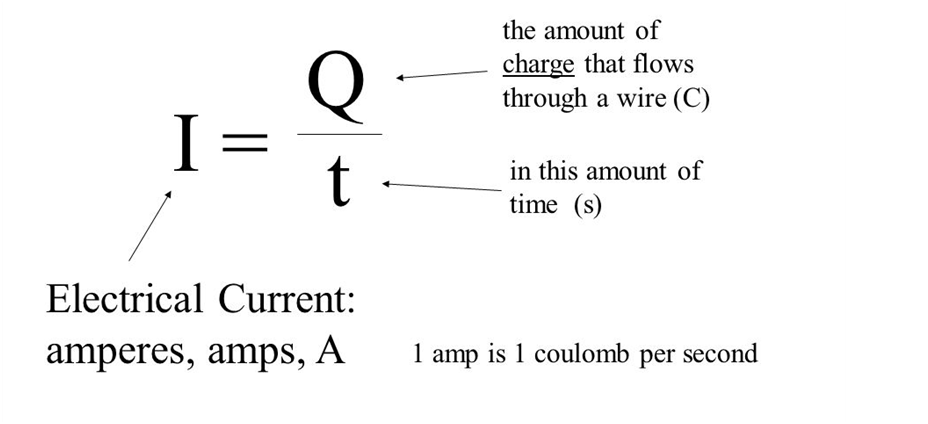
Now let's understand how we get the above formula.
In the figure given below is a conductor in which charges are flowing
And we imagine a small area held normal to the direction of flow of charge like shown in dark purple color in the diagram given below.
Now through this area suppose both positive and negative charge is flowing in the forward direction across the area.
Let q+ be the positive charge flowing forward through the area
And q- be the negative charge flowing forward through the area.
Then the Net charge crossing the chosen small area is q= q+ - q-
This net charge flowing through a small cross-section is actually proportional to ‘t’ for a steady current

The above proportionality can be understood properly with a suitable analogy. Suppose on a national highway, there is a toll plaza. Imagine that the vehicles cross that toll plaza at a steady rate. If you count the number of vehicles crossing the toll plaza for one hour you will get say 100, If you keep counting the vehicles for 10 hours, you will get 1000 vehicles crossing that toll plaza. The more time has elapsed, the number of vehicles passing that toll plaza will be more.
But currents are not always steady and hence more generally, we can define current as I=
Or simply by
Here we have considered
Units of Electric current
S.I. units of electric current is Ampere.
Definition of one ampere
I = Q / t ; when Q=1 C and t= 1s then I = 1 A.
If one coulomb of charge passes through a cross-section in one second, then the current through that area is one ampere (A).
Conventional and electronic current
At the time when this phenomenon of electric current was discovered, electrons had not yet been discovered so it was thought that electric current is due to the flow of positive charges. So the conventional direction of electric current is taken in the direction of the flow of positive charges.
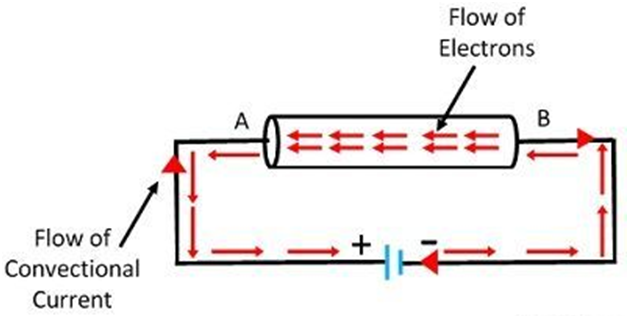
However, a negative charge moving in one direction is equivalent to a positive charge moving in the opposite direction. Later on, electrons were discovered by J. J Thomson and it was later established that electric current in conductors is due to the motion of free electrons. The direction of flow of electrons in a conductor or we can say that electronic current is opposite to the direction of flow of positive charges and hence also opposite to the direction of conventional current.
Electric current : Scalar / vector ?
What do you think? An electric current should be a scalar or vector. Many students can say as the electric current has both direction and magnitude it must be a vector. But this is not correct. Actually, electric current is a scalar quantity.
Even though it has direction, it does not follow vector addition laws. Electric current is a scalar quantity because the laws of ordinary algebra are used to add electric currents and the law of vector addition is not applicable here
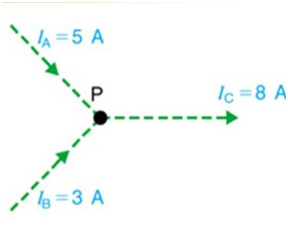
For example, in the figure shown below, we have three wires and three currents. IA= 5 A, IB= 3 A and both are incoming currents toward point P. Ic must be an outgoing current with magnitude = ( IA+ IB = 8 A). current in wire C is calculated via scalar addition and not vector addition laws. So electric current is a scalar quantity.
Electric current in the conductor.
When a charged particle is placed in an electric field, it will experience an electric force on it and will begin to move and this motion of charge will contribute to electric current. Now the question is every matter is made of atoms and in every atom, we have electrons and protons, so does it mean that every matter should conduct electricity when placed in an electric field?
The answer is no!
Let me tell you more precisely that electric current is due to the motion of free charges and not the bound charges. In most matters the electrons and protons in the matter are in a bound state, such matter cannot conduct electricity and are called insulators.
In other materials, notably metals, some of the electrons are practically free to move within the bulk material. These materials are generally called conductors. In solid metals, electricity is conducted by free electrons ( due to the flow of negative charge only). There are some other types of conductors like electrolytes in which conduction is due to ions both positive and negative charged ions.
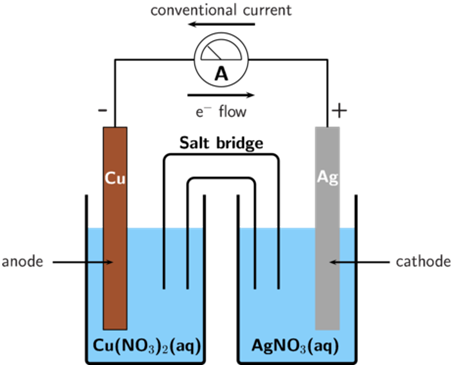
In this text, we will focus only on metals for conduction.
Now another question arises at any point in time, any metals have a very large number of free charges. So is there always an electric current in the metals? Again the answer would be No! Because if it happens then you could no longer touch any metals. You will get an electric shock if you do so.
The main question is why does it happen?
At any time free electrons inside the conductors are in motion due to thermal agitation ( in other words due to thermal energy). In this motion, they collide with each other and also with the fixed ions. Electrons colliding with ions emerge at the same speed as an elastic collision.

But due to the random motion of the free charges inside the conductor, there is no preferred direction of motion. The number of electrons traveling in any direction will be equal to the number of electrons traveling in the opposite direction. So there will be no net electric current
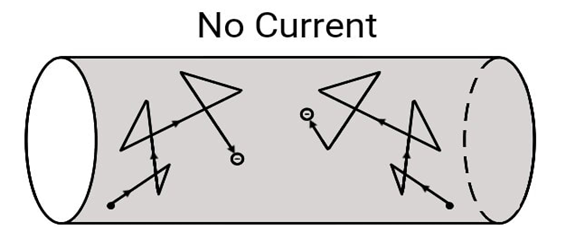
Let us see now what will happen to such a piece of the conductor when we apply an electric field to it. Imagine we have a cylindrical conductor with a uniform circular cross-section. When we apply an electric field at the cross-section. The electrons will experience a force in a direction opposite to the direction of the applied electric field.
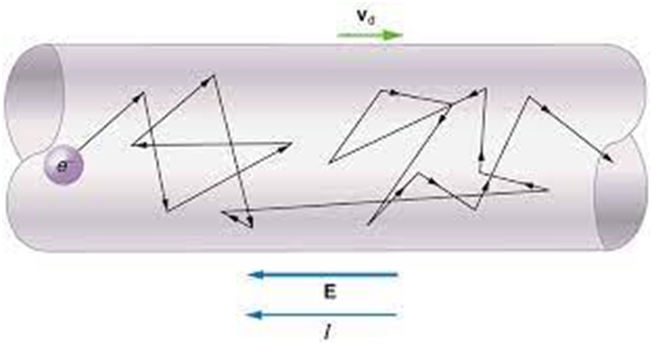
The electrons are accelerated toward the positive terminal, even now it collides with other electrons and ions in its path, but there is a preferred direction of drift of electrons called ‘Vd’ which is opposite to the direction of the applied electric field and current. This is all about Electric current and conductors.

 Grow Career Publication
Grow Career Publication
 Madhava Publications
Madhava Publications
